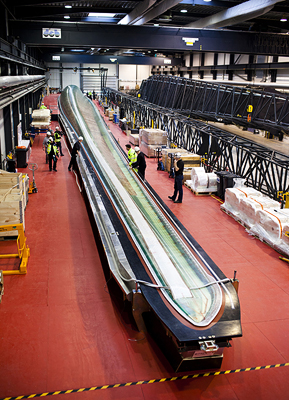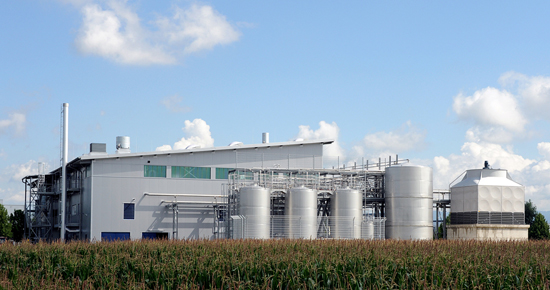Ianadmin
Rayonier Announces Ten Percent Dividend Increase
Rayonier has announced that its board of directors voted to increase the company’s regular quarterly cash dividend by $.04 per common share, or 10 percent, from $.40 per share to $.44, effective for the third quarter distribution.
The third quarter dividend is payable Sept. 28, 2012, to shareholders of record on Sept. 14, 2012. This is the company’s eighth dividend increase in the last ten years.
“Providing a secure and growing dividend to Rayonier shareholders remains a key strategic objective,” said Paul G. Boynton, Chairman, President and CEO. “This increase reflects our strong financial position and the continuing confidence we have in our businesses’ ability to generate increasing cash flows.”
Rayonier’s dividend is expected to be characterized as long-term capital gain and taxed at a maximum rate of 15 percent for most U.S. taxpayers.
Rayonier will announce second quarter earnings on July 26. The company will host a conference call and live webcast with the investment community at 2 p.m. EDT the same day to discuss the results. Investors may listen to the conference call by dialing 888-790-3052, passcode: Rayonier, or by logging onto http://www.rayonier.com.
Source: Rayonier
Siemens to supply 300 offshore wind turbines to DONG Energy
 with a capacity of 1,800 megawatts (MW). The agreement is based on the new SWT-6.0-154 direct drive wind turbine that will be installed in wind power plants off the British coast between 2014 and 2017. The world's largest rotor blade measuring 75 meters in length equaling a total rotor diameter of 154 meter will be deployed.
with a capacity of 1,800 megawatts (MW). The agreement is based on the new SWT-6.0-154 direct drive wind turbine that will be installed in wind power plants off the British coast between 2014 and 2017. The world's largest rotor blade measuring 75 meters in length equaling a total rotor diameter of 154 meter will be deployed.Endress+Hauser strengthens calibration business
Group acquires minority in CompuCal Calibration Solutions
Endress+Hauser has been providing high level calibration solutions to the process industries for many years. To strengthen this position, the Group has now acquired a minority share in Irish company CompuCal Calibration Solutions (CCS). The stake will ensure appropriate access to CCS’ technology and the further development of the calibration management software package ‘CompuCal’.
“‘CompuCal’ fits perfectly into our Plant Asset Management suite of integrated software tools,” underlines Dr Raimund Sommer, Managing Director of Endress+Hauser Process Solutions, the strategic dimension of the acquisition. “We have worked with CCS for the last decade and the company has proven to be a reliable and trusted partner. Endress+Hauser’s stake cements our close relationship.”
Automated and optimized workflows for calibration of field instruments have an important impact on yield and quality. This is not only critical for regulated industries. Demands on compliance according to industry standards often lead to additional workload in terms of calibration documentation management.
Endress+Hauser offers calibration management solutions along with calibration management service agreements which are individually aligned to the business requirements of customers. These solutions allow users to schedule and track instrument calibration and to produce paperless electronic reports that are compliant with relevant standards such as FDA’s CFR 21 Part 11.
Comprehensive offering for calibration management
Endress+Hauser’s solutions interface with mobile platforms and most common calibrators on the market. Well integrated into customers’ IT infrastructure and ERP systems such as SAP or IBM Maximo, the information gained through these solutions open up the path to improved quality and savings in operational expenditure.
Endress+Hauser’s calibration service offering ranges from calibration management and execution agreements through to training and the complete planning, installation and commissioning of calibration systems according to relevant good manufacturing practice requirements, e.g. GAMP. Consultancy and services for optimizing the calibration management process are also part of the offering.
Components and system solutions for complex applications and processes
 Multi-port valve blocks for cost-effective plant design
Multi-port valve blocks for cost-effective plant designStora Enso CEO Jouko Karvinen comments on second quarter 2012 results announced today
“On our way into growth markets supported by strong cash flow”
“We close the second quarter of 2012 with a mixed report. Both cash flow and liquidity continued to improve year-on-year whereas operational EBIT remained at about the level of the first quarter, as we also guided in April.
“In operations we had significant scheduled maintenance stoppages in Biomaterials, and late in the quarter we added production curtailments in Printing and Reading and Building and Living to fight the clearly weakening market conditions. It is clear that the continuing issues in the eurozone started to have a more material impact on our key markets during the later part of the second quarter, especially in the Building and Living and Printing and Reading Business Areas. In Printing and Reading the cyclical weakness is amplified by the ongoing structural change towards digitalisation of media and advertising that we have seen in Europe since 2007.
“The reality, as for most of the past five years since 2007, is that the environment is not going to get any easier. We need to double our own efforts to get through the short-term and long-term challenges. Operationally, every Business Area needs not only to complete the announced restructuring programmes, and the literally hundreds of cost and productivity improvement efforts, but also to add more of them and implement them faster. We also must and will continue to adjust our manufacturing capacity to the market demand, as we have been doing since late in the second quarter. This is crucial not only to maximise our margins with a focused market and product mix, but also to further demonstrate that we can get through the market cycles with continued solid cash generation.
“This cash flow is critical for us to continue to move the Group into higher-return growth markets with strong and defendable competitive positions. Completion of the Ostrołęka light-weight board machine, Skoghall Mill upgrade and Montes del Plata Pulp Mill are all steps on this transformation path. They will be followed by the strategic consumer board investment in Guangxi, China. This is our road into a new, growth market future.”
Stora Enso Interim Review January–June 2012
Clariant launches biofuel of the future
- Germany's largest cellulose ethanol plant inaugurated in Straubing
- CEO Hariolf Kottmann: A milestone in the strategy for sustainable products and processes
- Federal Minister of Research Annette Schavan: National Research Strategy BioEconomy 2030
- Biofuel of the future cuts CO2 emissions by 95% without competing with food production

Clariant, the Swiss specialty chemicals company, today inaugurated Germany's biggest pilot plant for the production of climate-friendly cellulose ethanol from agricultural waste. Located in Straubing, Bavaria and supported by the Bavarian government and the Federal Ministry for Education and Research, the futuristic project will produce up to 1,000 tonnes of cellulose ethanol from around 4,500 tonnes of wheat straw based on the sunliquid® technology developed by Clariant. It represents an investment of around 28 million euros. Studies show that Germany potentially has around 22 million tonnes of straw that could be used for energy production without compromising essential soil regeneration. This would be sufficient to cover around 25% of Germany’s current gasoline requirements.
In the presence of Federal Minister Annette Schavan and the Bavarian Minister of Economic Affairs, Martin Zeil, Clariant CEO Hariolf Kottmann declared: "The inauguration of the new plant marks an important milestone in the production of a climate-friendly biofuel that can also be used as a raw material for the chemical industry." Kottmann appealed to politicians and industrialists to draw lessons from the failed start-up of biofuel E10 and to seek open dialogue with all interested parties. "Only when society recognizes the environmental benefits of climate-friendly biofuels can second-generation bioethanol be successful ." Kottmann called for stable and reliable framework conditions and an extension of the tax exemption status for second-generation biofuels beyond 2015.
Federal Minister Annette Schavan said “This plant clearly demonstrates that products traditionally based on petroleum can be manufactured to the same standard using biomass. Thus this new plant serves as an important contribution to a sustainable Bio-Economy”.
As far as Bavarian economics minister, Martin Zeil, is concerned, there is no better place for the pilot plant than Straubing. “Here at Bavaria’s competence center for renewable raw materials, we don’t just have the raw material straw but above all also the necessary scientific backup in the form of both university and non-university research facilities. If we can make the breakthrough here using the sunliquid technology, it will create a raft of new options in terms of jobs and earnings potential in what is essentially a rural area. And from a global perspective, there’s no ‘food or fuel’ issue when plant waste is recycled.”
The plant at the Bavarian BioCampus in Straubing is logistically well-located right next to the Donau harbour, and will procure its raw materials largely from the Straubing region. The Mayor of Straubing, Markus Pannermayr, welcomed Clariant’s involvement in the area, describing it as the “most innovative major ‘green chemistry’ company at the Bavarian BioCampus.” He also underlined his willingness to work with district administrator Alfred Reisinger toward the sustainable provision of biomass for industrial utilization in the context of the “Green Chemistry Belt” strategy for the Danube region.
Professor Andre Koltermann, Head of Clariant's Biotech & Renewables Center, added: "We have been developing the sunliquid technology since 2006 and have been testing the method on a pilot scale since 2009." In an area encompassing approximately 2,500 square meters, all the process steps will be performed that will later be used in an industrial-scale plant; the aim of which is to confirm the technological feasibility of the sunliquid technique. "The results we obtain in Straubing will enable us to plan industrial production plants efficiently and economically, and ultimately to realize such plants in cooperation with partners," continued Koltermann.
The sunliquid process is an innovative biotechnological method that turns plant waste products such as grain straw and corn straw into second-generation cellulose ethanol.
Xerium Technologies Schedules Second Quarter 2012 Conference Call
Xerium Technologies, Inc., a leading global manufacturer of industrial textiles and rolls used primarily in the paper production process, today announced that it plans to release financial results for the second quarter 2012, ending June 30, 2012, after the close of regular market trading on Monday, August 6, 2012.
The company plans to hold a conference call on the following morning:
| Date: | Tuesday, August 7, 2012 | |
| Start Time: | 9:00 a.m. Eastern Time | |
| Domestic Dial-In: | +1-866-831-6247 | |
| International Dial-In: | +1-617-213-8856 | |
| Passcode: | 73944707 | |
| Webcast & Slide Presentation: | ||
To participate on the call, please dial in at least 10 minutes prior to the scheduled start. A live audio webcast and replay of the call, in addition to a slide presentation, may be found in the investor relations section of the company's website at http://www.xerium.com.
Source: Xerium Technologies, Inc.
New director builds brands
Henk Bremer assumed the position of Commercial Director on 16 April. He says, resolutely: “We are entering a new phase in the Satino story. The first huge step, i.e. thinking in terms of brands, has been completed and the next step is to accelerate and deepen our Satino activities. I see contributing to the future prospects of this fantastic company as an exciting challenge.”

Henk Bremer is a specialist when it comes to transforming a product-driven organisation into a more market-driven business. He was one of the driving forces behind the process that transformed clothing company Vlisco in Helmond from a textile printing business into an international fashion brand. “Building brands, linking specific experiences to products and achieving growth; those are our targets for the coming years”, says Henk Bremer.
“As a small, trendsetting paper producer in a fiercely competitive market, we simply have to differentiate ourselves even more strongly. Satino Black has been positioned excellently in the market during the past three years, but our brand portfolio is much broader and we have so many other products in our range. Not only do we intend to link them to the CSR story, we are also going to convince consumers that loyally buying our branded products is exciting, fun and trendy.”
Satino Black is an excellent example of how to successfully build a brand, he says. “We got the market talking, generated interest in the product, innovated at product level and gave our CSR activities their own individual face. My job now is to innovate even more strongly in the market in order to achieve further growth. We will succeed by positioning the Satino brand even more clearly, by adapting our thinking to focus even more strongly on brands, by becoming more successful in regions outside the Benelux and by developing promotions to give the Satino brand an extra boost.”
Assuring the future of the entire organisation is our central concern. Henk Bremer: “That is a very lengthy process; in fact, it's something that will always be ongoing. Our main objective is to stay in the spotlight, in the same way as Adidas, Apple or Spa Reine continually manage to do so. The future development of Satino involves coming up with something new again each year for each generation. We want to stay in the news and continue to set the trend. Via our communication campaigns on some occasions, based on products on other occasions, or based on the way we handle customers and business relations. So we will always put our energy into increasing and constantly improving the presence and attraction of our brands. The road to success is open to us and that is the road we will take.”
SCA´s acquisition of Georgia-Pacific´s European tissue business has been closed
SCA’s acquisition of Georgia-Pacific´s European tissue business has been completed. The purchase price amounts to EUR 1.32 bn on a debt-free basis. The acquired operations had sales in 2011 amounting to EUR 1.25 bn.
Georgia-Pacific has a well-established presence in Europe in both away-from-home and consumer tissue products. Their products in both segments are in particular marketed with the well-known Lotus brand.
“We are pleased that we now have closed the deal. The acquisition is a strategic fit that will strengthen our product offering with well-known brands and geographic reach in Europe. It also leads to substantial synergies”, says Jan Johansson, President and CEO of SCA.
The annual synergies are estimated at EUR 125m, with full effect in three years after closing. Related costs are estimated at EUR 130m.
The closing follows the EU clearance and its requirement that SCA divest Georgia-Pacific´s consumer tissue business in the UK including production capacity, Georgia-Pacific´s consumer tissue branded business in Benelux licensing out the Lotus brand during a limited time, and some of Georgia-Pacific´s and SCA´s retailer branded business in Scandinavia including production capacity. The businesses that are to be divested account for sales of approximately EUR 200m, which is in line with the expectations and does not change SCA´s evaluation of the deal.
Pöyry's January-June 2012 result news conferences on 27 July 2012
Pöyry's January-June 2012 result will be published on 27 July 2012 at 8:30 a.m. Finnish time. The result will be presented by CFO Jukka Pahta at the news conferences as follows:
- A conference for analysts, investors and press in Finnish will be arranged at 12 p.m. Finnish time at Restaurant Savoy, Eteläesplanadi 14, Helsinki, Finland.
- An international conference call and webcast in English will begin at 5:00 p.m. Finnish time (EEST).
10:00 a.m. US EDT (New York)
3:00 p.m. BST (London)
4:00 p.m. CEST (Paris)
5:00 p.m. EEST (Helsinki)
The webcast may be followed online on the company's website www.poyry.com. A replay can be viewed on the same site the next working day.
To attend the conference call, please dial
Finland: 0800 914672 Toll Free
UK: 0808 109 0700 Toll Free
USA: 1 866 966 5335 Toll Free
Other countries: +44 (0)20 3003 2666 (Standard International Access)
Conference id: Pöyry
Due to the live webcast, we kindly ask those attending the international conference call and webcast to dial in 5 minutes prior to the start of the event.
